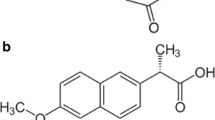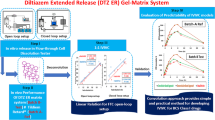Abstract
The aim of this present study was to investigate the ability of different dissolution methods to predict the in vivo performance of efonidipine hydrochloride (EFH). The solid dispersions of EFH were prepared by solvent evaporation method with HPMC-AS as matrix and urea as a pH adjusting agent. The paddle method, the open-loop, and the closed-loop flow-through cell methods were studied. In the study, Weibull’s model was the best fit to explain release profiles. The pharmacokinetics behaviors of two kinds of solid dispersions with different release rate were investigated in comparison to the EFH after oral administration in rats. In vivo absorption was calculated by a numerical deconvolution method. In the study, the level A in vivo and in vitro correlation (IVIVC) was utilized. The correlation coefficient was calculated and interpreted by means of linear regression analysis (Origin.Pro.8.5 software). As a result, excellent IVIVC for solid dispersions and crude drug (r2 = 0.9352–0.9916) was obtained for the dissolution rate determined with flow-through cell open-loop system in phosphate buffer solution with 0.1% (w/v) polysorbate 80 at pH 6.5, the flow-rate of 4 mL/min. In addition, the self-assembled flow cell system had good repeatability and accuracy. The dissolution rate of the solid dispersion could be slowed down by the flow-through method, and the difference caused by preparation was significantly distinguished. The study demonstrated that flow-through cell method of the open-loop, compared with paddle method, was suitable for predicting in vivo performance of EFH solid dispersions.














Similar content being viewed by others
References
Tanaka S, Sakai T, Masuda Y. Antihypertensive and diuretic effects of NZ-105, a novel dihydropyridine calcium antagonist. Eur J Pharmacol. 1990;183(4):1.
Masuda Y, Tanaka S. Efonidipine hydrochloride: a new calcium antagonist. Cardiovasc Ther. 2010;12(2):123–35.
Otsuka M, Maeno Y, Fukami T, Inoue M, Tagamic T, Ozekic T. Developmental considerations for ethanolates with regard to stability and physicochemical characterization of efonidipine hydrochloride ethanolate. Crystengcomm. 2015;17(38):7430–6.
Miyamoto M, Oda T, Bunrin T, Okabe T, Nishiyama T. Process for producing efonidipine hydrochloride preparation. United States patent US 6171599B1. 2001 Jan 09.
Otsuka M, Maeno Y, Fukami T, Inoue M, Tagami T, Ozeki T. Solid dispersions of efonidipine hydrochloride ethanolate with improved physicochemical and pharmacokinetic properties prepared with microwave treatment. Eur J Pharm Biopharm. 2016;108:25–31.
Mitsuyoshi N, Mitsutaka K, Toshihiko U, Ryuichi S, Atsuhiro M, Satoru N, et al. Pharmacokinetics and safety of NZ-105 in healthy volunteers: single-dose and multiple-dose studies. Jpn J Clin Pharmacol Ther. 1991;22(3):673–83.
Sunesen VH, Pedersen BL, Kristensen HG, Mullertz A. In vivo in vitro correlations for a poorly soluble drug, danazol, using the flow-through dissolution method with biorelevant dissolution media. Eur J Pharm Sci. 2005;24(4):305–13.
Jinno JI, Kamada N, Miyake M, Yamada K, Mukai T, Odomi M, et al. In vitro–in vivo correlation for wet-milled tablet of poorly water-soluble cilostazol. J Release. 2008;130(1):29–37.
Mccarthy CA, Faisal W, O'Shea JP, Murphy C, Ahern RJ, Ryan KB, et al. In vitro dissolution models for the prediction of in vivo performance of an oral mesoporous silica formulation. J Control Release. 2017;250:86–95.
Mercuri A, Fares R, Bresciani M, Fotaki N. An in vitro–in vivo correlation study for nifedipine immediate release capsules administered with water, alcoholic and non-alcoholic beverages: impact of in vitro dissolution media and hydrodynamics. Int J Pharm. 2016;499(1–2):330–42.
Medina JR, Salazar DK, Hurtado M, Cortes AR, Dominguez-Ramırez AM. Comparative in vitro dissolution study of carbamazepine immediate-release products using the USP paddles method and the flow-through cell system. Saudi Pharmaceut J. 2014;22(2):141–7.
Zerrouk N, Chemtob C, Arnaud P, Toscani S, Dugue J. In vitro and in vivo evaluation of carbamazepine-PEG 6000 solid dispersions. Int J Pharm. 2001;225(1–2):49–62.
Kesisoglou F, Hermans A, Neu C, Yee KL, Palcza J, Miller J. Development of in vitro-in vivo correlation for amorphous solid dispersion immediate-release Suvorexant tablets and application to clinically relevant dissolution specifications and in-process controls. J Pharm Sci. 2015;104:2913–22.
Lue BM, Nielsen FS, Magnussen T, Schou HM, Kristensen K, Jacobsen LO, et al. Using biorelevant dissolution to obtain IVIVC of solid dosage forms containing a poorly-soluble model compound. Eur J Pharm Biopharm. 2008;69(2):650–7.
Kostewicz ES, Abrahamsson B, Brewster M, Brouwers J, Butler J, Carler S, et al. In vitro models for the prediction of in vivo performance of oral dosage forms. Eur J Pharm Sci. 2014;57:342–66.
Hu J, Kyad A, Ku V, Zhou P, Cauchon N. A comparison of dissolution testing on lipid soft gelatin capsules using USP apparatus 2 and apparatus 4. Dissolution Technol. 2005;12(2):6–9.
Bhardwaj U, Burgess DJ. A novel USP apparatus 4 based release testing method for dispersed systems. Int J Pharm. 2010;388(1):287–94.
Beyssac E, Lavigne J. Dissolution study of active pharmaceutical ingredients using the flow through apparatus Usp 4. Dissolution Technol. 2005;12(2).
Jantratid E, Janssen N, Reppas C, Dressman JB. Dissolution media simulating conditions in the proximal human gastrointestinal tract: an update. Pharm Res. 2008;25(7):1663–76.
Perng CY, Kearney AS, Palepu NR, Smith BR, Azzarano LM. Assessment of oral bioavailability enhancing approaches for SB-247083 using flow-through cell dissolution testing as one of the screens. Int J Pharm. 2003;250(1):147–56.
Cammarn SR, Sakr A. Predicting dissolution via hydrodynamics: salicylic acid tablets in flow through cell dissolution. Int J Pharm. 2000;201(2):199–209.
Real D, Orzan L, Leonardi D, Salomon CJ. Improving the dissolution of Triclabendazole from stable crystalline solid dispersions formulated for oral delivery. AAPS J. 2019;21. https://doi.org/10.1208/s12249-019-1551-4.
Committee of National Pharmacopoeia, Pharmacopoeia of P.R.China IV. 2015; 121–122.
Huang S, Zhang Q, Li H, Sun YQ, Cheng G, Zou M, et al. Increased bioavailability of Efonidipine hydrochloride nanosuspensions by the wet-milling method. Eur J Pharm Biopharm. 2018;130:108–14.
Liu X, Feng X, Williams RO, Zhang F. Characterization of amorphous solid dispersions. J Pharmaceut Investig. 2018;48(1):19–41.
D’Arcy DM, Liu B, Bradley G, Healy AM, Corrigan OI. Hydrodynamic and species transfer simulations in the USP 4 dissolution apparatus: considerations for dissolution in a low velocity pulsing flow. Pharm Res. 2010;27(2):246–58.
Thimmasetty J, Pandey GS, Babu PRS. Design and in vivo evaluation of carvedilol buccal mucoadhesive patches. Pak J Pharm Sci. 2008;21(3):241–8.
Yuksel N, Kanik AE, Baykara T. Comparison of in vitro dissolution profiles by ANOVA-based, model-dependent and -independent methods. Int J Pharm. 2000;209(1–2):57–67.
Zhang Y, Huo M, Zhou J, Zou A, Li W, Yao CL, et al. DDSolver: an add-in program for modeling and comparison of drug dissolution profiles. AAPS J. 2010;12(3):263–71.
Volpato NM, Silva RL, Brito APP, Gonçalves JCS, Vaisman M, Noël F. Multiple level C in vitro/in vivo correlation of dissolution profiles of two l-thyroxine tablets with pharmacokinetics data obtained from patients treated for hypothyroidism. Eur J Pharm Sci. 2004;21(5):655–60.
Malinowski H, Marroum P, Uppoor VR, Gillespie W, Ahn HY, Lockwood P, et al. Draft guidance for industry extended-release solid oral dosage forms. Development, evaluation and application of in vitro-in vivo correlations. Oxygen Transport Tissue XXXIII. 1997;423:269–88.
Suarez-Sharp S, Li M, Duan J, Shah H, Seo P. Regulatory experience with In vivo In vitro correlations (IVIVC) in new drug applications. AAPS J. 2016;18(6):1–12.
Mohamed MEF, Trueman S, Othman AA, Han JH, Ju TR, Marroum P. Development of in vitro–in vivo correlation for Upadacitinib extended-release tablet formulation. AAPS J. 2019;21:108.
Hens B, Corsetti M, Spiller RC, Marcianib L, Vanuytselc T, Tack J, et al. Exploring gastrointestinal variables affecting drug and formulation behavior: methodologies, challenges and opportunities. Int J Pharm. 2017;519(1–2):79–97.
Tang L, Khan SU, Muhammad NA. Evaluation and selection of bio-relevant dissolution media for a poorly water-soluble new chemical entity. Pharm Dev Technol. 2001;6(4):531–40.
Sun Y, Tang SF, Gao LQ. Dissolution testing of enalapril maleate tablets with flowing-through cell method and evaluation of in vivo-in vitro correlation. Chin J Pharmaceut Anal. 2009;29(4):560–3.
Acknowledgments
This project was supported by the Career Development Supporting Plan for Young and Middle-Aged Teachers in Shenyang Pharmaceutical University, China, No. (2015).
Author information
Authors and Affiliations
Corresponding author
Additional information
Publisher’s Note
Springer Nature remains neutral with regard to jurisdictional claims in published maps and institutional affiliations.
Rights and permissions
About this article
Cite this article
Cheng, X., Gao, J., Li, J. et al. In Vitro-In Vivo Correlation for Solid Dispersion of a Poorly Water-Soluble Drug Efonidipine Hydrochloride. AAPS PharmSciTech 21, 160 (2020). https://doi.org/10.1208/s12249-020-01685-1
Received:
Accepted:
Published:
DOI: https://doi.org/10.1208/s12249-020-01685-1




